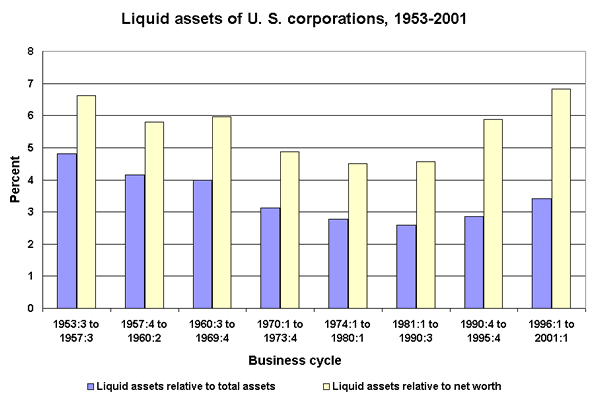A weekly presentation of downloadable charts and short analyses designed to graphically illustrate important economic issues. Updated every Wednesday.
Snapshot for January 16, 2002.
More customers, not more cash
As the economy remains in a slow or even negative growth pattern, the debate over the size and design of a fiscal stimulus package continues. Some proposals call for a reduction in corporate taxes that would presumably increase investment spending. Lower taxes, the theory goes, should free up additional resources for corporations, thereby providing them with more internal funds to invest in physical capital, especially new plants and equipment. The problem is that U.S. corporations already have enough cash, and what they really need are more customers before they begin investing again.
First, corporations already have a fair amount of liquidity. Liquid assets, the sum of money held in checking accounts, savings accounts, and money market mutual funds, was high and rising in 2000 and 2001 (see the chart below). During the late 1990s, liquid assets relative to total assets were, on average, higher than during the previous 30 years. Compared to corporate net worth, liquid assets were at their highest level ever. By the third quarter of 2001, liquid assets amounted to 3.8% of total assets (their largest share since the fourth quarter of 1967) and 7.9% of net worth, a historic record.

Second, companies already have more than enough capacity, as is clear by the fall of capacity utilization. According to the Federal Reserve Bank, industries were utilizing about 10% less of their available capacity in November 2001 than in June 2000, the most recent peak date for industrial capacity utilization. In fact, industrial capacity utilization in November 2001 was at its lowest level since May 1983.
With enough idle capacity and sufficient capital, a fiscal stimulus needs to offer corporations a way to get more customers, not more cash. A demand-side-focused stimulus package could include better unemployment benefits, more state revenue sharing, and other forms of increased government spending.
This week’s Snapshot by EPI economist Christian E. Weller.
Check out the archive for past Economic Snapshots.
